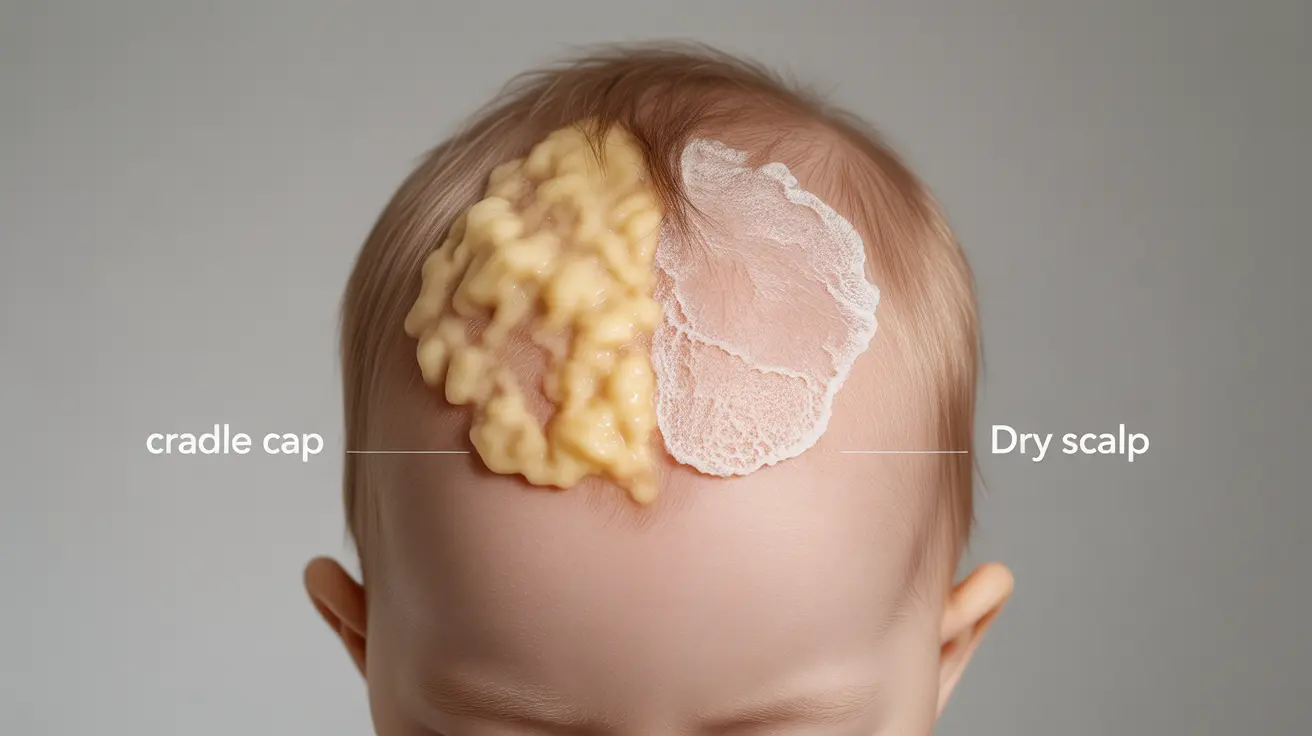As a new parent, noticing any scalp condition on your baby's head can be concerning. Two common conditions that often confuse parents are cradle cap and dry scalp. While they may appear similar at first glance, understanding their distinct characteristics is crucial for proper treatment and care.
This comprehensive guide will help you differentiate between cradle cap and dry scalp in babies, explore their causes, and provide effective treatment approaches for each condition.
Understanding Cradle Cap and Dry Scalp
Cradle cap (seborrheic dermatitis) and dry scalp are two distinct conditions that affect babies' scalps, but they have different characteristics and require different treatment approaches.
Physical Appearance and Symptoms
Cradle cap typically appears as thick, yellow or brownish, oily, scaly patches that stick to the scalp. These scales may have a crusty appearance and can sometimes appear on the eyebrows, behind the ears, or in skin folds. The affected area usually doesn't appear red or irritated unless scratched.
Dry scalp, on the other hand, presents as white, flaky skin that easily brushes away. The skin underneath may appear slightly red or irritated, and the condition might cause mild itching. The flakes are typically smaller and drier than cradle cap scales.
Causes and Risk Factors
Cradle Cap Causes
Cradle cap develops due to overactive sebaceous glands, which produce excess oil (sebum) on the scalp. This natural process is influenced by maternal hormones that remain in the baby's system after birth. The condition is not caused by poor hygiene or allergies.
Dry Scalp Causes
Baby dry scalp typically results from environmental factors such as:
- Low humidity
- Hot baths
- Harsh soaps or shampoos
- Excess washing
- Cold weather
- Dehydration
Treatment Approaches
Managing Cradle Cap
To treat cradle cap effectively:
- Massage baby oil, coconut oil, or olive oil into the scalp
- Let it sit for 15-20 minutes
- Gently brush the scales with a soft brush
- Wash with mild baby shampoo
- Repeat the process as needed
Addressing Dry Scalp
For dry scalp treatment:
- Use gentle, fragrance-free baby shampoo
- Reduce bathing frequency
- Maintain proper room humidity
- Apply baby-safe moisturizer
- Ensure adequate hydration
Prevention Strategies
While cradle cap often resolves on its own, you can help prevent both conditions by:
- Using mild, baby-specific hair care products
- Maintaining proper washing frequency
- Keeping the scalp clean and dry
- Using a humidifier in dry environments
- Avoiding harsh chemicals or adult hair products
When to Seek Medical Help
Consult your pediatrician if you notice:
- Severe redness or inflammation
- Bleeding or cracking skin
- Signs of infection
- Spread beyond the scalp
- No improvement with home treatment
- Excessive discomfort or irritability
Frequently Asked Questions
What are the main differences between cradle cap and dry scalp in babies?
Cradle cap appears as thick, yellowish, oily scales that stick to the scalp, while dry scalp presents as white, easily removable flakes. Cradle cap is caused by overactive oil glands, whereas dry scalp results from environmental factors and lack of moisture.
How can I tell if my baby has cradle cap or just dry scalp?
Check the appearance and texture of the flakes. Cradle cap scales are yellowish, oily, and stick to the scalp, while dry scalp produces white, dry flakes that brush away easily. Dry scalp may also cause more itching and irritation.
What causes cradle cap and how is it different from dry scalp causes?
Cradle cap is caused by overactive sebaceous glands influenced by maternal hormones. Dry scalp is typically caused by environmental factors like low humidity, harsh soaps, or excessive washing.
How should I treat cradle cap versus dry scalp at home for my baby?
Treat cradle cap with oil massages and gentle brushing to remove scales. For dry scalp, focus on moisturizing the scalp, using gentle products, and maintaining proper humidity levels in the environment.
When should I see a doctor for my baby's cradle cap or dry scalp symptoms?
Seek medical attention if you notice severe redness, inflammation, bleeding, signs of infection, or if the condition spreads beyond the scalp or doesn't improve with home treatment.




